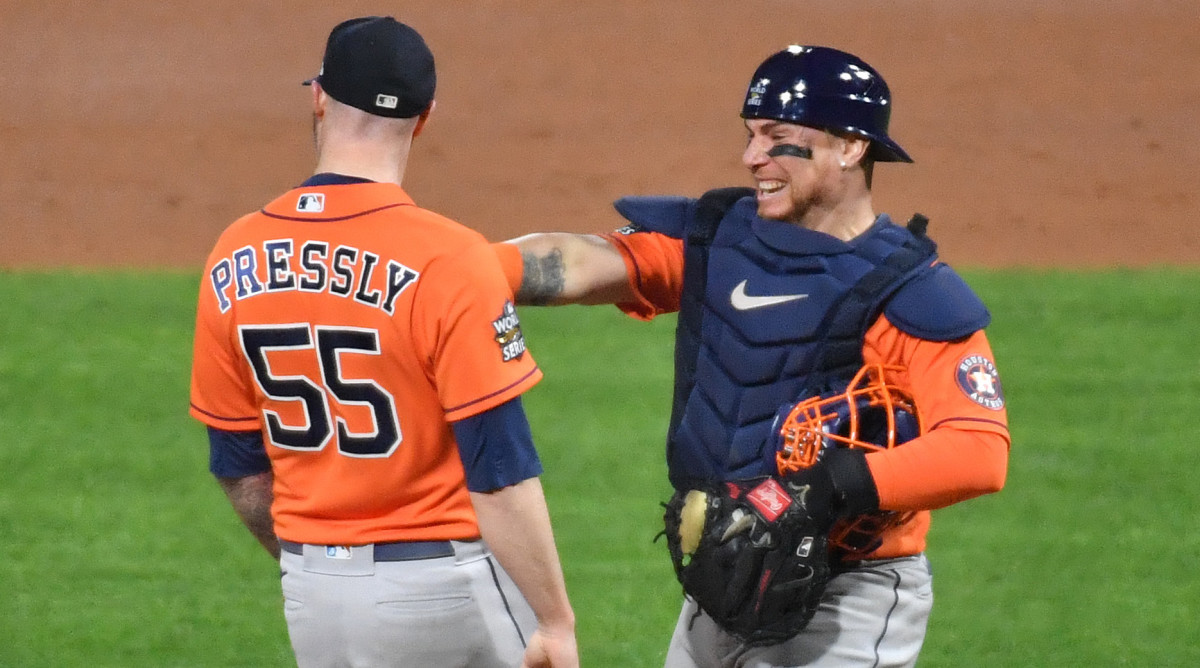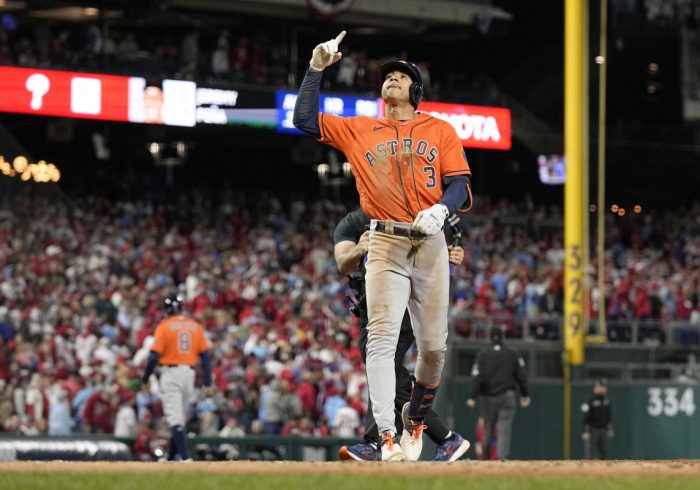PHILADELPHIA — While the rest of the baseball world was arguing about the relative merits of a combined no-hitter, the man who combined with no one to catch it was signing a baseball bound for the Hall of Fame.
Christian Vázquez, does a combined no-hitter count as a no-hitter?
He grinned. “It’s a no-hitter,” he said.
Some day, perhaps, fans will recall this 5–0 Astros victory in a slog of a World Series Game 4 only because it evened the series at two games apiece. Cristian Javier dazzled the Phillies through six innings, Bryan Abreu struck out all three batters he faced, Rafael Montero was perfect for one frame and Ryan Pressly worked around a walk to finish it off.
The players’ somewhat muted celebration afterward—no dogpile, just some animated handshakes—indicated that they regarded the four-pitcher effort more as a victory than as a moment in history. That image will probably not match the one of the Yankees’ Don Larsen flinging himself into the arms of Yogi Berra in Game 5 of the 1956 World Series against the Dodgers.
And yet Vázquez couldn’t hide his joy. Catching a no-hitter is typically one of the most cherished accomplishments of a backstop’s career. In some ways, a combined no-hitter might indicate an even more impressive performance for a catcher than a solo one: He had to navigate four different arsenals, four different mentalities, four different personalities. He shepherded them through nine innings, 30 batters, 141 pitches, three hours and 25 minutes. They shook him off just four times.
“There’s only two catchers in history to call a no-hitter [in the World Series],” he said proudly, repeating a statistic he had just learned but would probably not forget. He added, “We’ve not finished the job yet, but this is very, very special for us. And when we get old we’re going to remember this.”
Astros catcher Christian Vázquez, right, celebrates with pitcher Ryan Pressly after the final out of Game 4.
Eric Hartline/USA TODAY Sports
This has been a memorable season in ways both good and bad. He began the year with the Red Sox—the club that selected him out of the Puerto Rico Baseball Academy in the ninth round of the 2008 draft, the club where he played eight years and won the ’18 World Series. He was the longest-tenured member of the organization when, amid the team’s second consecutive last-place season, GM Chaim Bloom traded him to Houston at the deadline for a pair of prospects.
The catcher’s old team was playing a series against his new team at the time. Vázquez, stunned, packed his belongings and trudged through the Minute Maid Park concourse to the home clubhouse. He had been the starter in Boston; now he would back up Martín Maldonado. Those first few days were hard, Vázquez said, as he had to play against his friends. But once the Red Sox left, he began to feel more comfortable. He introduced himself to the Astros and tried to catch as many bullpens as possible to accelerate his familiarity with the pitchers.
Even on a team that had seen success—this is Houston’s fourth World Series in six years—his history in the sport stood out.
“I think he’s proven himself across his years in the league,” said reliever Ryne Stanek. “The guy’s won a World Series. He’s played in the playoffs. He’s done it for almost a decade. He’s a guy that’s been there, done that. So it’s hard not to trust him.”
Manager Dusty Baker likes to pair Maldonado with Justin Verlander, Framber Valdez and Lance McCullers, Jr., and Vázquez with Javier. The two began Game 3 of the American League Championship Series against the Yankees with 5⅓ one-hit innings; five relievers then combined to finish the shutout.
“I think that’s the first time I’ve seen two guys with the same first name as a battery,” Baker said. “So maybe that was part of it.” (Somehow it seems Baker has forgotten that his 2017 Nationals boasted the iconic Matt Wieters–Matt Albers pairing.)
Said Javier, “He stayed on top of me, continued to motivate me throughout the game, and called a great game, and gave me really good positive energy, and I think that’s one of the reasons why we got the results we did today.”
That would be a win, a tied World Series and no hits, thanks to four pitchers—and one catcher.
More MLB Coverage:



